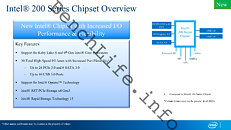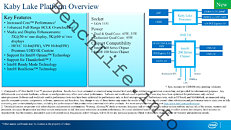Tuesday, November 17th 2015

Intel 7th Generation Core "Kaby Lake" and 200-series Chipset Platform Outlined
Intel's tick-tock product development cycle is disturbed. The cadence of launching a new CPU microarchitecture on a given silicon fab process, miniaturizing it to a smaller fab process, and then launching an even newer micro-architecture on that process; is about to change with the company's 7th generation Core "Kaby Lake" processor. When launched, it would be the third microarchitecture built on the company's 14 nm process, besides "Skylake" (current new architecture) and "Broadwell" (miniaturization of "Haswell" to 14 nm.) Some of the very first documents related to Kaby Lake began to move about, making news along the way. The architecture is scheduled to launch along with its companion 200-series chipset some time in 2016.
To begin with, Core "Kaby Lake" will continue to be built on the LGA1151 package, and will likely be backwards compatible with existing 100-series chipset motherboards with a firmware update. From what we get to understand from leaked material, it will not be a vastly newer architecture than Skylake, at least not of the kind Skylake was to Broadwell. There are still CPU performance enhancements on offer, an "enhanced full-range BClk overclocking," which could mean improved overclocking on chips with upwards-locked multipliers (although we won't get our hopes too high and call it a return of the BClk overclocking era). A bulk of the R&D will fall into improving the integrated graphics, to support multiple 5K displays, 10-bit HVEC and VP9 hardware-acceleration; platform-integrated Thunderbolt 3, and platform interface support for Intel Optane (3D XPoint memory).Like its predecessor, "Kaby Lake" will feature an integrated memory controller that supports both DDR4 and DDR3 memory. It will support faster DDR4-2400 natively; and DDR3L-1600. DMI 3.0 (physical PCI-Express 3.0 x4) will continue to be the chipset bus. The 200-series chipset, codenamed "Union Point," in its topmost variant, will feature native support for Intel Optane SSDs, and will feature greater port-flexibility among its downstream PCIe lanes. It will feature Rapid Storage Technology support for PCIe storage devices. By the time it launches, NVMe will achieve greater presence in the market.
Since it will be built on the existing 14 nm process, TDP of "Kaby Lake" chips will be similar to existing "Skylake" ones - 35W and 65W for dual- and quad-core desktop chips; with 95W for enthusiast-K variants of the desktop chips. Elsewhere in the lineup, there will be 8 top-level variants of "Kaby Lake," four of which will launch in Q3-2016, and four in early-2017, as incremental lineup upgrades.
Source:
Benchlife.info
To begin with, Core "Kaby Lake" will continue to be built on the LGA1151 package, and will likely be backwards compatible with existing 100-series chipset motherboards with a firmware update. From what we get to understand from leaked material, it will not be a vastly newer architecture than Skylake, at least not of the kind Skylake was to Broadwell. There are still CPU performance enhancements on offer, an "enhanced full-range BClk overclocking," which could mean improved overclocking on chips with upwards-locked multipliers (although we won't get our hopes too high and call it a return of the BClk overclocking era). A bulk of the R&D will fall into improving the integrated graphics, to support multiple 5K displays, 10-bit HVEC and VP9 hardware-acceleration; platform-integrated Thunderbolt 3, and platform interface support for Intel Optane (3D XPoint memory).Like its predecessor, "Kaby Lake" will feature an integrated memory controller that supports both DDR4 and DDR3 memory. It will support faster DDR4-2400 natively; and DDR3L-1600. DMI 3.0 (physical PCI-Express 3.0 x4) will continue to be the chipset bus. The 200-series chipset, codenamed "Union Point," in its topmost variant, will feature native support for Intel Optane SSDs, and will feature greater port-flexibility among its downstream PCIe lanes. It will feature Rapid Storage Technology support for PCIe storage devices. By the time it launches, NVMe will achieve greater presence in the market.
Since it will be built on the existing 14 nm process, TDP of "Kaby Lake" chips will be similar to existing "Skylake" ones - 35W and 65W for dual- and quad-core desktop chips; with 95W for enthusiast-K variants of the desktop chips. Elsewhere in the lineup, there will be 8 top-level variants of "Kaby Lake," four of which will launch in Q3-2016, and four in early-2017, as incremental lineup upgrades.


47 Comments on Intel 7th Generation Core "Kaby Lake" and 200-series Chipset Platform Outlined
Non-K chips like i5-4690 also support Vt-d, I'd buy i5-4690 since it has the best performance per dollar and it supports Vt-d.
Pune is near Mumbai, in India.
The 200 series chipsets also looks boring. While 100 series offered big improvements (mainly 20 PCIe 3.0 lanes vs the previous 8 PCIe 2.0 lanes), this one is pretty much the same as the 100 series except for the Optane support (there is no product based on Optane yet and I'm pretty certain the 1st gen Optane will be too expensive for most consumers just like when SSD first came out).
Intel has been slacking for too long and I really wish Zen would give them a wake-up call.
It really needs to be Haswell/Broadwell IPC or its a bust in my mind.